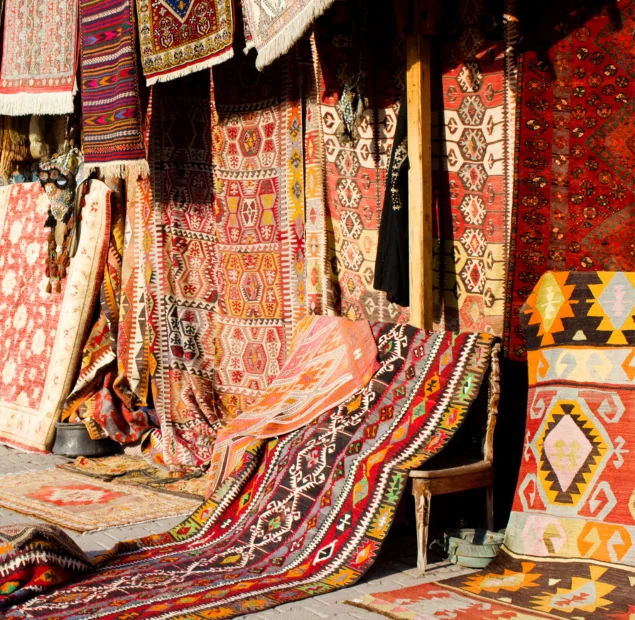Regional rug styles
Rugs From Around the world
There are a lot of knotting techniques around the world.
While weaving started out as a handicraft, eventually mechanization followed.Today, Rugs could be Hand-knotted, Machine knotted or Hybrid.At Weave & Design, we pride ourselves for providing you with the most luxurious and hardwork laden Rugs Weaving technique – Hand Weaved Rugs!The choice of the knotting technique will depend on the desired look & feel, intended usage, durability.
Rugs from Iran



Persia is synonymous with Rugs! Iran has been the oldest and one of the highest-quality rug producers for centuries.
In Tabriz, a city with a rich weaving heritage, rugs reveal intricate medallion motifs, arabesques, and majestic palmettes. Isfahan, famous for its exemplary refinement, weaves floral elegance with lush gardens and poetic patterns in its rugs. Kashan is the paradigm of silken creations. It infuses delicate flora and ethereal imagery.
Renowned figures like Hajijalili and Seirafian have become legends. Their delicate artwork has left an indelible mark on world history.
Persian rugs transcend mere floor coverings… These rugs have been used in diverse spaces, from gracing grand palaces to humble abodes, evoking warmth and splendor.
A Persian Rug could almost be considered an investment, as it is likely to be treasured as a classic piece through the years.
Indian Rugs
In the heart of the Indian subcontinent, a facet of the broader Oriental rug tradition stands – as intricate masterpieces that reflect the soul of a diverse and enchanting land.
The landscape of rug production in India is just as vibrant & diverse, as the culture here – from capturing the arid terrains of Rajasthan to the picturesque valleys of Kashmir. Each region brings a unique thread to the intricate tapestry of Indian rug-making.
Patterns reminisce ancient palaces and sacred temples, a symphony of colors, and motifs.
Like the intricate “paisley” evoke the intricate elegance of Mughal art, while “jaali” motifs mirror the enchanting lattice windows of Indian architecture. Indian Rug Designs are often a symphonic fusion of geometric precision and organic flow, balancing between tradition and modernity.
Thus, creating ‘masterpieces’ that grace floors and elevate spaces. Collectors and connoisseurs from all over the world, recognize not just the artistry, but also the historical narrative woven into each stitch.


Turkish Rugs
Threads of Simplicity and Geometric Beauty
A Turkish rug is a symphony of colors, patterns, and history!
Turkish rugs showcase Anatolian landscapes, grand palaces, and nomadic wanderings.
Among these, Turkish kilims stand out as radiant gems, revered world over for their geometric motifs that dance like mathematical poetry depicting nomadic life and ancient rituals. These flat-woven masterpieces are reflections of a people who express their identity through vibrant symbols and patterns.
Oushak rugs have soft palettes and spacious designs. They capture the essence of Anatolian elegance.
Hereke rugs which are born from imperial looms, evoke opulence with intricate medallions and silk threads.
Moroccan Rugs
Moroccan flat woven rugs are Geometric shapes, zigzag patterns, and diamond motifs that are more than mere decoration pieces. They are a celebration of the rawness and tribal roots of Morocco.
They mostly use wool to speak a language of symbolism and storytelling.
Among Moroccan rugs, Beni Ourain and Azilal rugs stand out as luminous symbols of Moroccan craftsmanship.
Beni Ourain rugs, born from the Atlas Mountains, emulate an understated elegance with their ivory hues and minimalist designs.
Azilal rugs, on the other hand, burst forth in a riot of colors, with each thread being a brushstroke in an oozing tapestry of creativity.
Yet, beyond their aesthetic appeal, each rug carries meaning – from protective motifs to representations of daily life; they are cultural expressions of the enigmatic beauty of North Africa. Inviting the viewer to traverse through the sands of the Sahara and feeling the heartbeat of nomadic life.

